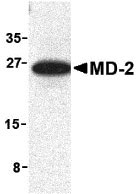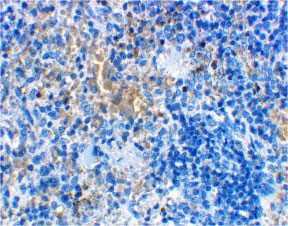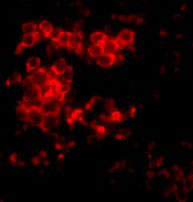MD-2 Antibody
- 产品详情
- 实验流程
- 背景知识
Application
| WB, IF, E, IHC-P |
|---|---|
| Primary Accession | Q9Y6Y9 |
| Other Accession | NP_056179, 223555998 |
| Reactivity | Human, Mouse, Rat |
| Host | Rabbit |
| Clonality | Polyclonal |
| Isotype | IgG |
| Calculated MW | 18546 Da |
| Concentration (mg/ml) | 1 mg/mL |
| Conjugate | Unconjugated |
| Application Notes | MD-2 antibody can be used for detection of MD-2 by Western blot at 0.5 to 2 µg/mL. Antibody can also be used for immunohistochemistry starting at 2 µg/mL. For immunofluorescence start at 10 µg/mL. |
| Gene ID | 23643 |
|---|---|
| Other Names | MD-2 Antibody: MD2, MD-2, ly-96, ESOP-1, ESOP1, MD2, Lymphocyte antigen 96, Ly-96, lymphocyte antigen 96 |
| Target/Specificity | LY96; |
| Reconstitution & Storage | MD-2 antibody can be stored at 4℃ for three months and -20℃, stable for up to one year. As with all antibodies care should be taken to avoid repeated freeze thaw cycles. Antibodies should not be exposed to prolonged high temperatures. |
| Precautions | MD-2 Antibody is for research use only and not for use in diagnostic or therapeutic procedures. |
| Name | LY96 |
|---|---|
| Synonyms | ESOP1, MD2 |
| Function | Binds bacterial lipopolysaccharide (LPS) (PubMed:17569869, PubMed:17803912). Cooperates with TLR4 in the innate immune response to bacterial lipopolysaccharide (LPS), and with TLR2 in the response to cell wall components from Gram-positive and Gram-negative bacteria (PubMed:11160242, PubMed:11593030). Enhances TLR4-dependent activation of NF-kappa-B (PubMed:10359581). Cells expressing both LY96 and TLR4, but not TLR4 alone, respond to LPS (PubMed:10359581). |
| Cellular Location | Secreted, extracellular space. Secreted Note=Retained in the extracellular space at the cell surface by interaction with TLR4 (PubMed:10359581). |
For Research Use Only. Not For Use In Diagnostic Procedures.
Provided below are standard protocols that you may find useful for product applications.
BACKGROUND
MD-2 Antibody: MD-2 is a member of the Toll/interleukin-1 receptor (TIR) family, a group of proteins that include the Toll-like receptors (TLRs). TLRs are signaling molecules that recognize different pathogen-associated molecular patterns (PAMPs) and serve as an important link between the innate and adaptive immune responses. TLR4, the major signaling receptor for lipopolysaccharide (LPS), requires the binding of MD-2 to its extracellular region for maximal response to LPS. The specificity of this response is determined by the species of MD-2; e.g., human MD-2 can cause mouse TLR4 to react to LPS analogs that are normally antagonistic to human but not mouse TLR4.
REFERENCES
O’Neill LAJ, Fitzgerald FA, and Bowie AG. The Toll-IL-1 receptor adaptor family grows to five members. Trends in Imm. 2003; 24:286-9.
Vogel SN, Fitzgerald KA, and Fenton MJ. TLRs: differential adapter utilization by toll-like receptors mediates TLR-specific patterns of gene expression. Mol. Interv. 2003; 3:466-77.
Takeda K, Kaisho T, and Akira S. Toll-like receptors. Annu. Rev. Immunol. 2003; 21:335-76.
Janeway CA Jr and Medzhitov R. Innate immune recognition. Annu. Rev. Immunol. 2002; 20:197-216.
终于等到您。ABCEPTA(百远生物)抗体产品。
点击下方“我要评价 ”按钮提交您的反馈信息,您的反馈和评价是我们最宝贵的财富之一,
我们将在1-3个工作日内处理您的反馈信息。
如有疑问,联系:0512-88856768 tech-china@abcepta.com.























 癌症的基本特征包括细胞增殖、血管生成、迁移、凋亡逃避机制和细胞永生等。找到癌症发生过程中这些通路的关键标记物和对应的抗体用于检测至关重要。
癌症的基本特征包括细胞增殖、血管生成、迁移、凋亡逃避机制和细胞永生等。找到癌症发生过程中这些通路的关键标记物和对应的抗体用于检测至关重要。 为您推荐一个泛素化位点预测神器——泛素化分析工具,可以为您的蛋白的泛素化位点作出预测和评分。
为您推荐一个泛素化位点预测神器——泛素化分析工具,可以为您的蛋白的泛素化位点作出预测和评分。 细胞自噬受体图形绘图工具为你的蛋白的细胞受体结合位点作出预测和评分,识别结合到自噬通路中的蛋白是非常重要的,便于让我们理解自噬在正常生理、病理过程中的作用,如发育、细胞分化、神经退化性疾病、压力条件下、感染和癌症。
细胞自噬受体图形绘图工具为你的蛋白的细胞受体结合位点作出预测和评分,识别结合到自噬通路中的蛋白是非常重要的,便于让我们理解自噬在正常生理、病理过程中的作用,如发育、细胞分化、神经退化性疾病、压力条件下、感染和癌症。








